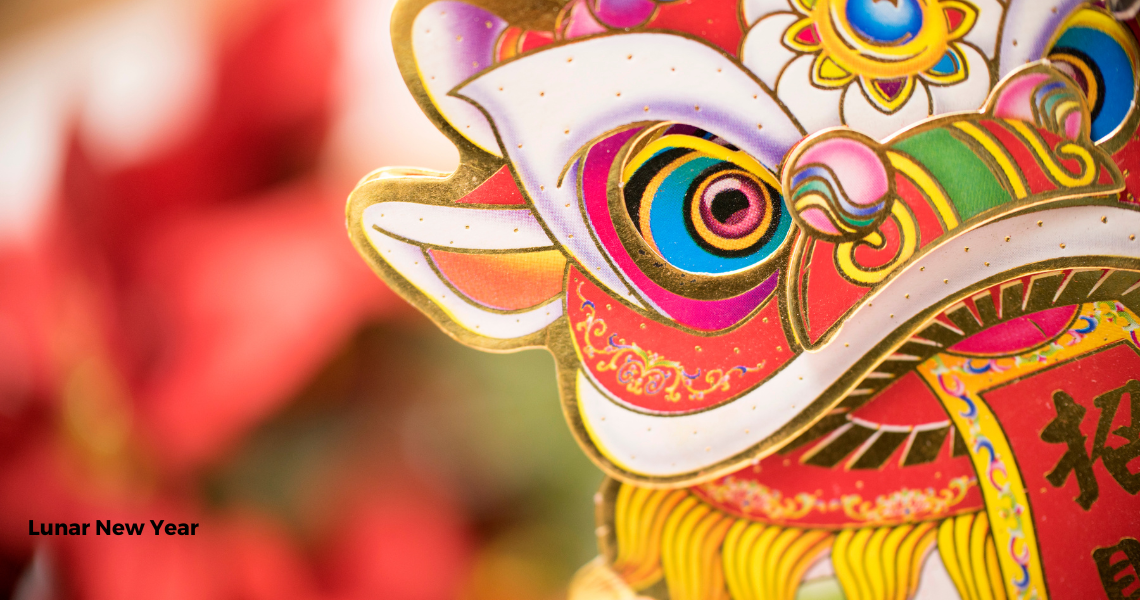News & Updates
Lunar New Year: 2024 The Year of the Dragon
Friday, 9 February 2024
Kicking off on Saturday 10 February and lasting for 15 days, the Lunar New Year is a celebration of the arrival of spring and the beginning of a new year on the lunisolar calendar, the Year of the Dragon.
Lunar New Year is the most important holiday in China, and it is also widely celebrated in South Korea, Vietnam, and countries with a significant overseas Chinese population. While the official dates encompassing the holiday vary by culture, it is a time for families to come together for cultural traditions, prepare for the good fortune to come, and, of course, enjoy great food.
Why do we say Lunar New Year instead of Chinese New Year?
Referring to the holidays as Lunar New Year is preferred because it is more inclusive of other Asian New Year celebrations. Different countries have their own name for the new year – in China, it is called Chūn jié; in Vietnam, it is known as Tết; in Korea, it is Seollal; and in Tibet, it is referred to as Losar.
Celebrating Lunar New Year around Asia
China
In China the Lunar New Year is celebrated with new clothes (usually in red and gold) and spent with family on New Year's Eve. Traditional food is shared such as fish, baos, pancakes, noodles, and dumplings. A lucky coin is also folded inside the dumplings which the children eagerly enjoy searching for and its tradition for family members give each other red envelopes with money inside.
Vietnam
Tết is the Vietnamese name for Lunar New Year and is traditionally celebrated with family visiting temples to pray for good luck, health and fortune. At home families celebrate with sticky rice cake snacks like bánh tét (a log-like, cylinder snack) and bánh chưng (a square cake) while wearing a tradition costume (the áo dài) which is a silk tunic with slits on either side that's worn over pants. Like China, children also receive red envelopes with money inside.
Korea
In Korea, it is most important to pay respect to your ancestors and elders during Lunar New Year. Children show their respect by wearing traditional costumes (known as hanbok) and perform deep bows (known as seh bae). The three day celebration is spent eating dishes like mandu (Korean dumplings) and dduk-guk (thinly sliced rice cake soup) and playing traditional games like Yut Nori, a board game played with wooden sticks and yeonnalligi (kite-flying) is done for good luck.
Malaysia
During the Lunar New Year celebrations in Malaysia, families gather for a joyfull reunion dinner, marking the arrival of spring. This festive period spans 15 days, concluding with the vibrant Chap Goh Mei celebration. Yee sang, a symbolic salad dish, graces dining tables, symbolizing prosperity, while Nian gao, a rice flour cake, is a beloved treat. Mandarin oranges signify good fortune, and red envelopes (ang pow) are gifted to youngsters and unmarried relatives. Additionally, traditional attire such as the cheongsam, often in auspicious red, adds to the colorful festivities.
Singapore
In Singapore, Lunar New Year is celebrated with delicacies like nian gao and pineapple tarts alongside the traditional yusheng salad. Red envelopes, symbolizing good luck, are exchanged, and paying homage to ancestors through temple visits is a cherished tradition. The vibrant Chingay Parade dazzles with its giant floats and lion dancers, while the River Hongbao festival stands as Singapore's largest Chinese New Year celebration, captivating audiences across the nation each year.
Taiwan
In Taiwan, the Lunar New Year is a time for families to reunite and celebrate together in their homes. Traditional dishes like Nian gao (dumplings) and pineapple are cherished during these festivities, symbolizing good fortune and prosperity for the coming year. Interestingly, it's believed to bring luck to leave some fish uneaten, ensuring abundance in the future. This cultural celebration highlights the importance of family, food, and auspicious customs in Taiwanese society during the Lunar New Year.
Philippines
As the clock strikes midnight in the Philippines, locals enthusiastically jump into the New Year, believing it will add inches to their height. Filipino families gather for Media Noche, a traditional midnight feast symbolizing prosperity for the upcoming year, with tables adorned with round fruits symbolizing good luck. Sticky rice delights like biko, bibingka, and nian gao are enjoyed during Lunar New Year for their symbolic significance in binding families together, while long noodles like pancit promise longevity and good fortune. An intriguing Lunar New Year superstition in the Philippines involves wearing polka dots, as the round shape is associated with wealth, prosperity, and financial abundance.
Reference Links:
